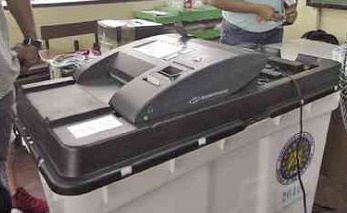
Vote-counting machine inside a precinct | INQUIRER FILE PHOTO
MANILA, Philippines — The former chief of the Department of Information and Communications Technology (DICT) wants the Supreme Court to have the transmission logs on the May 9 elections kept for review, amid a looming deadline on the deletion of the files in accordance with the law.
In an interview on Monday, former Information and Communications Technology Secretary Eliseo Rio Jr. said he would file a mandamus petition in the high court this week, so that data on the transmission logs can be kept and verified to check alleged discrepancies in the recording of the May 9 votes.
“The mandamus petition with the SC is just to preserve the transmission logs related to the transmissions of telcos from the VCMs (vote-counting machines) to the transparency server and the Comelec [Commission on Elections] central server,” Rio told the Inquirer.
He cited Section 13 of the cybercrime law (Republic Act No. 10175), regarding the “Preservation of Computer Data,” which stipulates that data “provided by a service provider shall be preserved for a minimum period of six months from the date of… receipt.”
Law enforcement authorities may order “a one-time extension, … provided that once [said] data… is used as evidence in a case, the mere furnishing… of the transmittal document to the Office of the Prosecutor shall be deemed a notification to preserve the computer data until the termination of the case.”
Otherwise, the data may be deleted six months from their entry—which in the case of the May 9 election data would be on Nov. 9, or 16 days from today.
“We need these transmission logs to clear our observations that there is discrepancy between the transmissions to the transparency server and the central server,” Rio said. “If they get deleted by Nov. 9, then all evidence… will be gone.”
Peak transmission
Rio explained that the transparency server handled by the Parish Pastoral Council for Responsible Voting (PPCRV), which showed partial and unofficial results, registered more than 20 million votes by 8:02 p.m. on May 9. Comelec data around that time, however, showed that only 12 million votes were transmitted.
He also noted that the PPCRV server saw peak transmission at that particular time, whereas Comelec data showed peak transmission around 9:30 p.m., or over an hour later.
“This is impossible because all VCMs transmit their data… at the same time,” he said.
Rio said he had been asking for the transmission logs since July, but Comelec Chair George Garcia presented the data only on Oct. 18, during a forum by the Ateneo School of Government.
He also questioned how the transparency server was able to receive more than 20 million votes in just an hour after voting closed.
In a post on Facebook, he said that “in the whole history of Philippine elections, and maybe in the whole world, this was the first time counting of votes peaked at the very first hour, despite the fact that in that first hour, the Comelec General Instruction required the printing of (eight) copies of the precinct Election Result (ER) before any transmissions can be made.”
Rio said printing the ERs took at least 30 minutes.
“The transmission logs will determine if there are irregularities in the transmissions, which in turn will determine if the May 9 election was rigged,” he said.
“If Comelec has nothing to hide, why don’t they simply show these transmission logs to the public?” he added.
RELATED STORIES
Experts bare trust issues with Comelec
No massive fraud in May 9 polls, says US election forensics expert
Fraudulent way to victory: Cheating in PH elections

